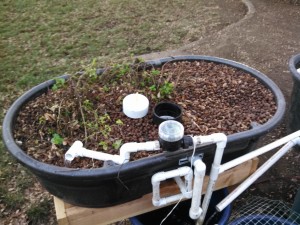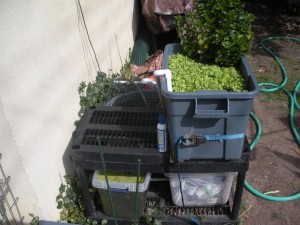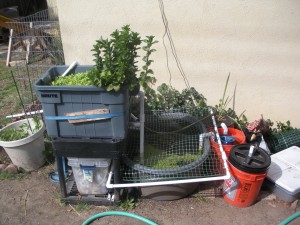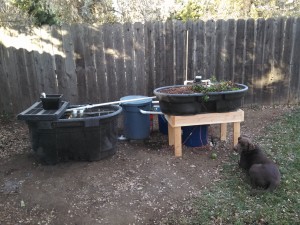When I started in aquaponics I decided to go with a media grow bed for many reasons, but primarily because it seemed the simplest to start with. Additionally I chose to use a flood and drain design (or ebb and flow) over a constant flow system, because it seemed the best for the plants based on my reading. The decision was then how to accomplish the flood and drain cycle. For the most part flood and drain media grow bed design is split between two designs: timer based and siphon based. My goal was to cycle the fish tank water at least once per hour and have a 1:1 fish tank/grow bed ratio.
A quick review for those who are in the know or a crash course for those who aren’t:
In timer based designs the pump is normally turned on and off in a cycle to fill the grow bed, with a drain in the bottom that empties slower than the grow bed fills. When the pump is turned off the water slowly drains from the grow bed.
Pros:
- -Simple to set up and less fine-tuning
- -Pump only runs part time, which saves power
- -Fills quickly
- -Consistent cycle
- -More control of the cycle
Cons:
- -Pump must be larger to fill grow bed quickly enough and cycle the fish tank water
- -Cycling the pump is hard on it and reduces life span
- -Water is only circulating part time
- -Slow to drain
In siphon based designs the pump normally runs continuously filling the grow bed and an auto-siphon is used to time the flood and drain cycle. When the water level is high enough the siphon is triggered and will drain the grow bed quickly until the siphon breaks when the grow bed is empty, then the cycle repeats.
Pros:
- -Less stress on the pump
- -Water is continuously cycled and allows for extra flow to be used for aeration
- -Drains quickly
Cons:
- -Siphons can be hard to get tuned (especially if you are new)
- -Cycle is not always consistent
- -Fills slower
- -Frequent cycles can over water plants
- -Less control of the cycle
After doing my research I used a siphon for about a week on Nerd Pond 0.5 then switched to a timed design for version 0.6, as I couldn’t get the siphon to work quite right. Nerd Pond 1.0 used the same pump and timer. The current Nerd Pond grow bed uses a hybrid timer/siphon design to fill and drain the grow bed every hour. This system uses a modified garden watering timer to water the grow bed for 15 minutes every hour. The grow bed is drained using a loop siphon, this allows the grow bed to be completely filled before any water starts to drain, thus decreasing the time and amount of flow needed to fill the grow bed. The loop siphon is sized to be overwhelmed by the inflow of water, so it will not stop until the water stops flowing. This setup allows for the pump to run continuously, the grow bed to fill quickly at the beginning of the cycle, and drain quickly at the end of the cycle, while maintaining a consistent controlled flood and drain cycle. To make it even better multiple small grow beds with carefully synchronized timers allow for a smaller pump to be used and still achieve the proper fish tank to grow bed ratio.

You can see the round water timer rigged to be AC power, the loop siphon, and the overflow in this picture. The water will not normally reach the overflow unless the tank recirculation valve is closed. It takes about five minutes for the grow bed to fill, at that point the water level will start to recede very slowly until the timer turns off. Once the water stops flowing the grow bed will completely empty in another five minutes.
Note: Currently the fish tank is not fully stocked, so the pond has a 2:1 fish tank to grow bed ratio, a second grow bed and timer is planned to be added this summer.



